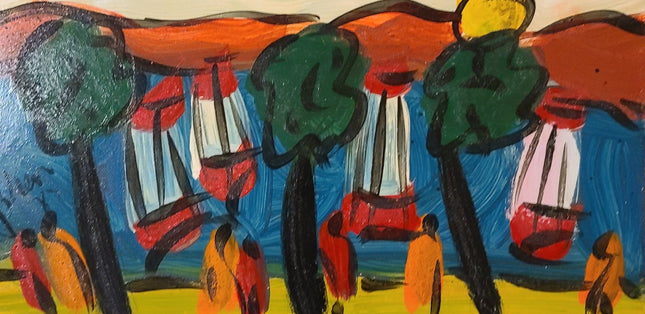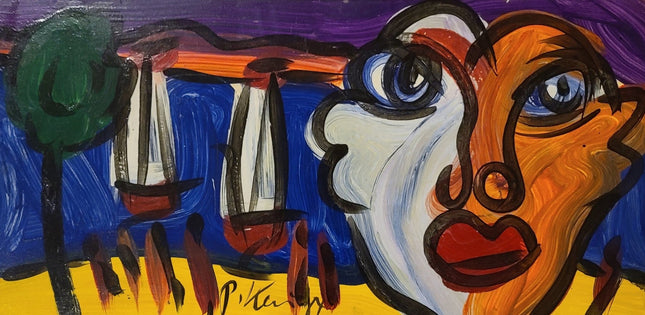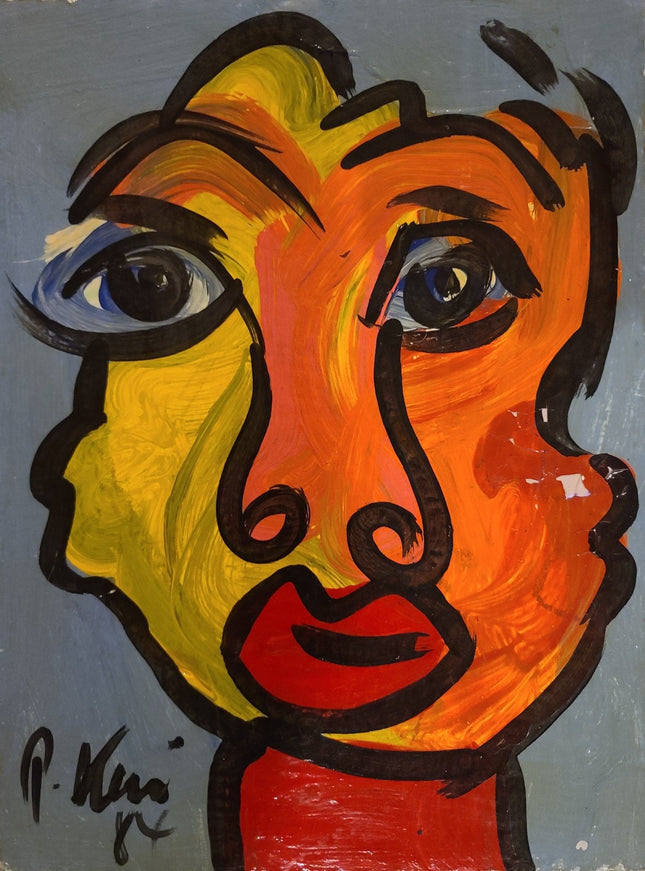
Germany

Peter Keil Island Yachting 84 Original Oil Painting by Peter Keil
Island Yachting 84 Original One of a Kind Oil Mixed Media Painting Artwork on Masonite Board by Popular Modern Impressionist Artist Peter Keil. 1984 Signed 24x12 Original Peter Keil Painting of Boats on the Lake Unveiling "Island Yachting '84" by Peter Keil "Island Yachting '84" is an original oil mixed media painting on Masonite board, a distinctive piece by Peter Keil, a celebrated modern impressionist artist. Signed and dated in 1984, this 24x12 artwork depicts a vibrant scene of boats on a lake, a subject that Keil approaches with his characteristic abstract flair and robust use of color. His portrayal of the yachting scene is not confined to the mimetic representation but is a lively expression of the scene's rhythm and the artist's emotional response. This piece exemplifies Keil's integration of Street Pop Art and Graffiti Artwork aesthetics into his impressionistic style. This synthesis has marked his place in modern art. Keil's choice of Masonite board as his canvas reflects his affinity for mediums that resonate with the authenticity and rawness of street art. The material's inherent durability and smooth surface make it an ideal foundation for Keil's vigorous painting style, allowing for the thick application of oil paint, a hallmark of his work. The textural qualities of "Island Yachting '84" give it a tactile presence and capture the transient effects of light and movement, much like the fleeting nature of graffiti art. The Artistic Merit of "Island Yachting '84" The artistic merit of "Island Yachting '84" lies in its dynamic composition and the expressive power of its brushwork. The sweeping gestures and bold contours that define the boats and their reflections in the water demonstrate Keil's prowess in conveying motion and depth. The painting's foreground is dominated by dark, silhouetted figures that starkly contrast the brightly colored yachts, creating a visual dialogue between the elements. This technique of determining light and dark, color and form, is reminiscent of the dramatic tension found in street murals and pop art imagery, a quality that Keil masterfully incorporates into his work. Keil's employment of mixed media also indicates his experimental approach to art-making. By combining various materials and techniques, he crafts a complex visual experience that challenges traditional boundaries and evokes the layered textures of urban street art. "Island Yachting '84" is thus not only a representation of a lakeside leisure activity but a manifestation of the artist's innovative spirit and contribution to the discourse of Street Pop Art and Graffiti Artwork. Impact and Legacy of Peter Keil's Work The impact and legacy of Peter Keil's work, as exemplified by "Island Yachting '84," are deeply rooted in his ability to infuse traditional impressionist motifs with the energy and spontaneity of street art. His distinctive style, characterized by an expressive use of line and color, has influenced a generation of artists who seek to bridge the gap between the gallery and the street. Keil's paintings are celebrated for their vivacity and capacity to engage viewers on both an aesthetic and visceral level. Moreover, "Island Yachting '84" reflects Keil's broader vision for art as a medium that is accessible and relatable. His deliberate choice to work with materials and subjects directly correlating to everyday experiences speaks to his desire to democratize art, a principle at the heart of Street Pop Art and Graffiti Artwork. Through pieces like this, Keil invites the viewer to partake in a visual journey that is both intimate and universal, a journey that is underscored by the unifying power of art. "Island Yachting '84" is a testament to Peter Keil's innovative blending of genres, a vibrant piece that captures the essence of his artistic inquiry. It is a compelling example of how the sensibilities of Street Pop Art and Graffiti Artwork can be translated into a more traditional art form, maintaining their inherent vibrancy and immediacy. As Keil's work continues to inspire and resonate, "Island Yachting '84" remains a significant piece within the oeuvre of an artist who has consistently pushed the boundaries of expression and form.
$553.00

Peter Keil Face Yachting 84 Original Oil Painting by Peter Keil
Face Yachting 84 Original One-of-a-Kind Oil Mixed Media Painting Artwork on Masonite Board by Popular Modern Impressionist Artist Peter Keil. 1984 Signed 24x12 Original Peter Keil Painting of a large face and Boats on the Lake Peter Keil's Child's Face '84: A Fusion of Expressionism and Street Pop Art The "Child's Face '84" by Peter Keil stands as a vibrant example of how modern impressionist techniques can intersect with the ethos of Street Pop Art and Graffiti Artwork. Measuring 12x16 inches, this original oil mixed media painting on cardboard brings forth the distinct style of Keil, often recognized for his spontaneous, bold approach to modern art. The painting, which presents a giant boy's face, encapsulates the innocence and expressiveness associated with children, rendered through the lens of Keil's vivid, impressionistic style. Characteristic of Peter Keil's original works, this piece exhibits some paint chipping on the cheek, a natural consequence of the artist's heavy impasto technique and the delicate nature of cardboard as a medium. The chips do not detract from the artwork's impact; instead, they add to the piece's narrative, reflecting the passage of time and the tactile history of Keil's artistic process. This textural element, common in Keil's originals, underscores the raw, unfiltered emotion he seeks to capture in his subjects. Interpreting Keil's Artistic Language in Child's Face '84 Interpreting Keil's "Child's Face '84" requires an appreciation of his artistic language, which merges the abstracted forms of impressionism with street art's vibrant colors and emotional immediacy. Keil's portrayal goes beyond simply representing a child's features; it explores character and emotion conveyed through exaggerated forms and a rich color palette. The large, luminous eyes dominate the composition, serving as windows to the child's soul and echoing the depth of human experience that Keil aims to explore through his art. The choice of cardboard as a substrate for this piece mainly tells of Keil's intention to bridge the gap between conventional fine art and the more accessible, everyday materials often used in Street Pop Art and Graffiti Artwork. This unconventional choice reflects a democratization of art, a key theme in street art, where the emphasis is on making art available and relatable to a broad audience. By utilizing cardboard, Keil challenges traditional art norms and aligns himself with a form of artistic expression grounded in the realities of urban life. The Lasting Influence of Keil's Approach to Portraiture The lasting influence of Peter Keil's approach to portraiture is evident in "Child's Face '84." His work, often categorized under the umbrella of modern impressionism, resonates with a broader range of art forms, including Street Pop Art and Graffiti Artwork. Keil's contribution to these genres lies in his ability to infuse traditional portrait painting with a sense of immediacy and street-wise rawness often found in urban art. This painting, with its bold contours and striking colors, is a testament to Keil's innovative spirit and impact on contemporary art. Furthermore, the painting's vibrant quality, a defining characteristic of Keil's work, underscores the expressive potential of Street Pop Art and Graffiti Artwork. "Child's Face '84" exemplifies how these genres can convey complex emotional narratives, challenging the perception that street art is solely concerned with public commentary or social critique. Keil's portrait is a celebration of individuality and the human spirit, encapsulated within the gaze of a child and articulated through the medium of paint. Peter Keil's "Child's Face '84" is a significant piece that captures the intersection of modern impressionism with the dynamic world of Street Pop Art and Graffiti Artwork. The painting's spontaneous execution, vibrant colors, and textural nuances contribute to its enduring appeal and status as a meaningful representation of Keil's artistic vision. As a piece that bears the marks of its creation, it continues to engage and inspire, offering a window into the depth and diversity of Keil's oeuvre.
$553.00

Peter Keil Childs Face 84 Original Oil Painting by Peter Keil
Childs Face 84 Original One of a Kind Oil Mixed Media Painting Artwork on Cardboard by Popular Modern Impressionist Artist Peter Keil. 1984 Signed 12x16 Original Peter Keil Painting of a large child boy's face. Some paint chipped on the cheek, as is common with Peter Keil originals. Peter Keil's Child's Face '84: A Fusion of Expressionism and Street Pop Art The "Child's Face '84" by Peter Keil stands as a vibrant example of how modern impressionist techniques can intersect with the ethos of Street Pop Art and Graffiti Artwork. Measuring 12x16 inches, this original oil mixed media painting on cardboard brings forth the distinct style of Keil, often recognized for his spontaneous, bold approach to modern art. The painting, which presents a giant boy's face, encapsulates the innocence and expressiveness associated with children, rendered through the lens of Keil's vivid, impressionistic style. Characteristic of Peter Keil's original works, this piece exhibits some paint chipping on the cheek, a natural consequence of the artist's heavy impasto technique and the delicate nature of cardboard as a medium. The chips do not detract from the artwork's impact; instead, they add to the piece's narrative, reflecting the passage of time and the tactile history of Keil's artistic process. This textural element, common in Keil's originals, underscores the raw, unfiltered emotion he seeks to capture in his subjects. Interpreting Keil's Artistic Language in Child's Face '84 Interpreting Keil's "Child's Face '84" requires an appreciation of his artistic language, which merges the abstracted forms of impressionism with street art's vibrant colors and emotional immediacy. Keil's portrayal goes beyond simply representing a child's features; it explores character and emotion conveyed through exaggerated forms and a rich color palette. The large, luminous eyes dominate the composition, serving as windows to the child's soul and echoing the depth of human experience that Keil aims to explore through his art. The choice of cardboard as a substrate for this piece mainly tells of Keil's intention to bridge the gap between conventional fine art and the more accessible, everyday materials often used in Street Pop Art and Graffiti Artwork. This unconventional choice reflects a democratization of art, a key theme in street art, where the emphasis is on making art available and relatable to a broad audience. By utilizing cardboard, Keil challenges traditional art norms and aligns himself with a form of artistic expression grounded in the realities of urban life. The Lasting Influence of Keil's Approach to Portraiture The lasting influence of Peter Keil's approach to portraiture is evident in "Child's Face '84." His work, often categorized under the umbrella of modern impressionism, resonates with a broader range of art forms, including Street Pop Art and Graffiti Artwork. Keil's contribution to these genres lies in his ability to infuse traditional portrait painting with a sense of immediacy and street-wise rawness often found in urban art. This painting, with its bold contours and striking colors, is a testament to Keil's innovative spirit and impact on contemporary art. Furthermore, the painting's vibrant quality, a defining characteristic of Keil's work, underscores the expressive potential of Street Pop Art and Graffiti Artwork. "Child's Face '84" exemplifies how these genres can convey complex emotional narratives, challenging the perception that street art is solely concerned with public commentary or social critique. Keil's portrait is a celebration of individuality and the human spirit, encapsulated within the gaze of a child and articulated through the medium of paint. Peter Keil's "Child's Face '84" is a significant piece that captures the intersection of modern impressionism with the dynamic world of Street Pop Art and Graffiti Artwork. The painting's spontaneous execution, vibrant colors, and textural nuances contribute to its enduring appeal and status as a meaningful representation of Keil's artistic vision. As a piece that bears the marks of its creation, it continues to engage and inspire, offering a window into the depth and diversity of Keil's oeuvre.
$282.00




